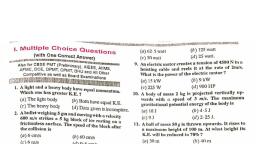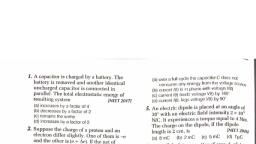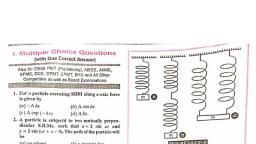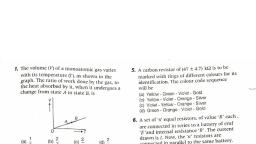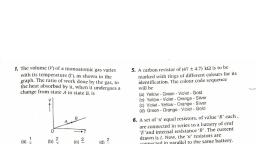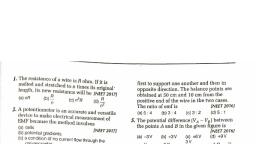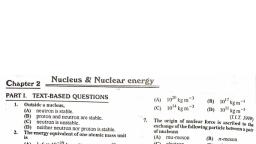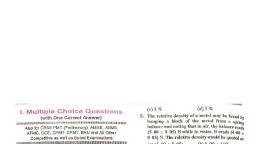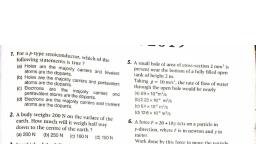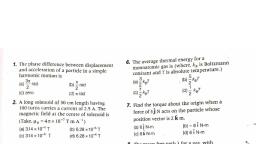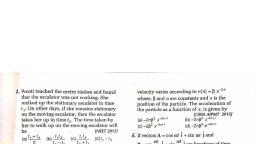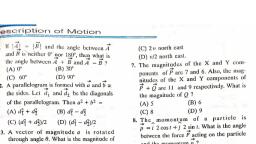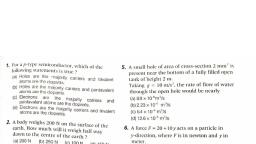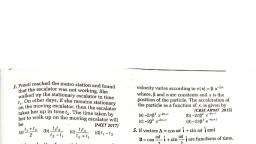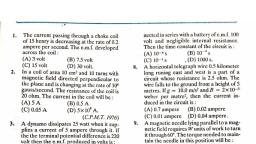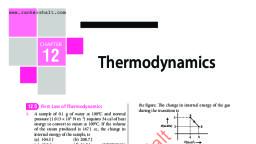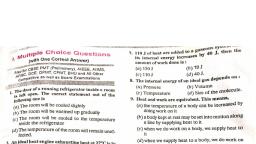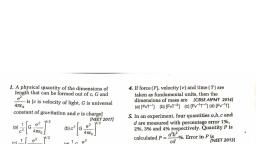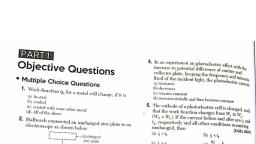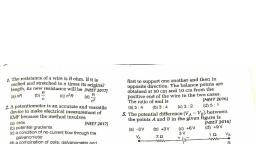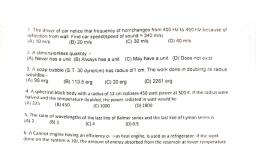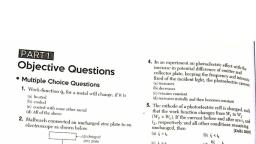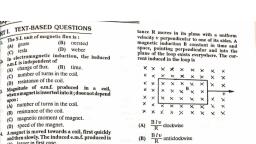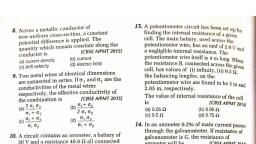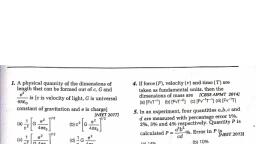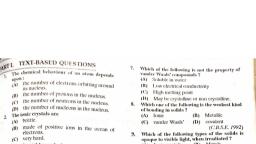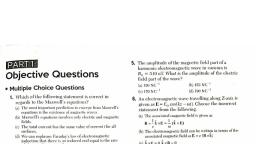Page 1 :
1. Thermodynamic processes are indi ., the following diagram el, , , , , , , , Match the following :, | Column-I | Column-II, P: | Process | a. | Adiabatic, Q. | Process Il b. | Isobdaric, R, | Process Ill ie Isachoric es, S. | Process IV d. | Isothermal, , , , , , , , fajP> a,Q>¢,A> 4, S7b, (b)P+ c,Q—a,A>d,S>b, {(}P3c,Q3d,R3b,S 3a, (d} P+ d, Q> b, Ra, soc, , 2. A gas mixture consists of 2 moles of 0, and, , 4 moles of Ar at temperature T- Neglecting, all vibrational modes, the total internal, , , , energy of the system is INEET 2017], (a) 4AT (b) 15AT, (c) 9AT (d) 14AT, , 3. A Carnot engine having an efficiency of sn, , as heat engine, is used as a refrigerator. If, the work done on the system is 10 J, the, amount of energy absorbed from the, reservoir at lower temperature is [NEET 2017], fajid (b) 90 J (co) 9d (d) 100 J, , 4. A black body is at a temperature of 5760 K., The energy of radiation emitted by the body, al wavelength 250 nm is U, at wavelength, 500 nm is U, and that at 1000 nm is Ge, Wien’s constant, b = 288 x 10° nmK. Which, , of the following is correct ? [NEET 2016), (a)U; =0 (b) U,>U,, (c} U3 >U, (d)U, =0, , 5., , A gas is compressed isothermally to half its, initial volume. The same gas is compressed, separately through an adiabatic process, until its volume is again reduced to half., Then (NEET 2016], {a) compressing the gas through adiabatic, process will require more work to be done., (b) compressing the gas isothermally or, , em will require the same amount of, worl, , (c) which of the case (whether compression, through isothermal or through adiabatic, Process) requires more work will depend upon, the atomicity of the gas., , (d) compressing the gas isathermally will require, More work to be done.
Page 2 :
6. A piece of ice falls from a height h so that, it melts completely. Only one-quarter of, the heat produced is absorbed by the ice, and all energy of ice gets converted into, heat during its fall. The value of h is, {Latent heat of ice is 3.4 x 10°J/kg and, g =10N/kg], , (a) 544km (6) 136km (c)68km (Gd) 34km, , 7. A refrigerator works between 4°C and 30°C., It is required to remove 600 calories of heat, , every second in order to keep the, temperature of the refrigerated space, constant. The power required is, (Take, 1 cal = 4.2 Joules), , (a) 23.65 W (b) 236.5 W (c) 2365 W (d) 2.365 W, Two identical bodies are made of a, material for which the heat capacity, , 8., , increases with temperature. One of these is, , at 100°C, while the other one is at 0°C. If, the two bodies are brought into contact,, then assuming no heat loss, the final, common temperature is, (a) 50°C, , (b) more than 50°C, , (c) less than 50°C but greater than 0°C, (d) °c, , A body cools from a temperature 37 to 2T, in 10 minutes. The room temperature is T,, Assume that Newton's law of cooling is, applicable. The temperature of the body at, the end of next 10 minutes will be, , 9., , °, , [NEET 2016], , z 3 4, , we at =T tr, , (a) al (0) 3 (c) 3 (d), , 10. One mole of an ideal monatomic gas, undergoes a process described by the, equation pV* = constant. The heat capacity, , of the gas during this process is [NEET 2016], , 3 5, = = R (d) R, (a) an (b) ae (c) 2 (d), , 11. The temperature inside a refrigerator is, t,°C and the room temperature is ¢,°C., The amount of heat delivered to the room, for each joule of electrical energy, , consumed ideally will be INEET 2016], @ ty (py 4273 (oy 2+273 ( tte, t-te t-te t-te t,+273, , INEET 2076], , [NEET 2016], , [NEET 2016], , 12, A given sample of an ideal gas occupies 4, volume V at a pressure p and absolute, temperature T. The mass of each molecule, of the gas is m. Which of the following, , gives the density of the gas? INET 20164, (a) pi (kT) (b) pm (kT), (c) p/(kTV) (d) mkT, , 13. On observing light from three different, stars P, Q and R, it was found that intensity, of violet colour is maximum in the, spectrum of P, the intensity of green colour, is maximum in the spectrum of R and the, intensity of red colour is maximum in the, spectrum of Q. If Tp, Tg and T;, are the, respective absolute temperatures of P,Q, and R, then it can be concluded from the, , above observations that {CBSE AIPMT 2015), (8) Tp > Tq > Tr (b) Tp > Tr > To, (0) Ie< Ta <To OIp<Io<Ta, , 14, The two ends of a metal rod are, , maintained at temperatures 100°C and, 110°C. The rate of heat flow in the rod is, found to be 4.0 J/s. If the ends are, maintained at temperatures 200°C and, 210°C, the rate of heat flow-will be, , [CBSE AIPMT 2015], (a) 44.0J/s (ob) 168U/s (c)B80U/s (d)4.0J/s, , 15. Figure below shows two paths that may be, , taken by a gas to go from a state A to a state, Cc. [CBSE AIPMT 2015], , , , 2x10Sni 4x10SnP, v—, , In process AB, 400 J of heat is added to the, , system and in process BC, 100 J of heat is, , added to the system. The heat absorbed by, , the system in the process AC will be, , (a) 380J (b)500J (c) 460J (d) 300 J, , 16. A Carnot engine, having an efficiency of, , n= 6 as heat engine, is used as a
Page 3 :
frigerator. If the work di, , ral the amount of en ca oie Te 22. Two vessels separately contain two ideal, , the reservoir at lower temperature is m gases A and B at the same temperature, the, pressure of A being twice that of B. Under, , a) 100) (0/99) “a Cue such conditions, the density of A is found, 7 s ; to be 1.5 times the density of B. The ratio, 47. One mole o an ideal diatomic gas of molecular weight of A and B is, undergoes a transition from A to B along a {CBSE AIPMT 2015], path AB as shown in the figure. @2 m2 2 (4, [CBSE AIPMT 2015} 3 4 ., , 23. The value of coefficient of volume, expansion of glycerin is 5 x 10 4x~*. The, fractional change in the density of glycerin, for a rise of 40°C in its temperature is, , {CBSE AIPMT 2015], , (a)0,015 = (b) 0.020 = (c) 0.025 (d) 0,010, 24, Steam at 100°C is passed into 20 8 of water, , , , The change in internal energy of the, A a gas at 10°C. When water acquires @, during the transition is temperature of 80°C, the mass of water, (a) 20k) = (b)=20KJ (c)20) = (d) - 12 Kd present will be (Take specific heat of water, . Cc =1cal g2°C" and latent heat of steam, 18. The ratio of the specific heats —* = yi +4, pe sacar a =540 cal g¢"'] {CBSE AIPMT 2014], terms of degrees of freedom (n) is given by (a)24g = (0) 31.5q (c) 42.59 (d) 2259, [CBSE AIPMT 2015] 25. Certain quantity of water cools from 70°C, 1 ii 2 in to 60°C in the first 5 min and to 54°C in the, (a) (1 + *) (0) (: + 4) (c) (: Ht 2) () (1 + 2) next 5 min, The temperature of the, surroundings is [CBSE AIPMT 2014], 19. An ideal gas is compressed to half its (a)45°C (by 20°C (42°C () 10°C, initial volume by means of several process. 26. A monoatomi, : c gas at a pressure p, having a, Which of the process results in the volume V expands isothermally to a, , 2, maximum work done on the gast volume 2 V and then adiabatically to a, , ‘CBSE AIPMT 2015] ", {a} Adiabatic (b) ult volume 16 V. The final pressure of the gas, (6) !sochoric (d) Isothermal is (take a °) pai ten, 20. 4.0 g of a gas occupies 22.4 L at NTP. The, specific heat capacity of the gas at constant (a)64p (bo) 82p_—c) 2 ia) 180, , volume is 5.0 JK™ 1 mol” }. If the speed of, , sound in this gas at NTP is 952 ms * then 27.4 thermodynamic system undergoes cyclic, the heat capacity at constant pressure is aig ABCDA as shown in figure. The, (Take gas constant R = 8.3 JK” 1 mol” *) work done by the system in the cycle is, , [CBSE AIPMT 2015], (a) 8.0 JK~* mol”! (b) 7.5 JK" | mol” 4, {c)7.0 JK-' mor * (@) 8.5 JK" * mol”, , 21. The coefficient of performance ofa, refrigerator is 5. If the temperature inside, freezer is — 20°C; the temperature of the, , surroundings to which it rejects heat is v; are ; ni [CBSE AIPMT 2015] » AV case AteMT 2014, , fare mate |= 11°C (d) 21°C (2)AMy —(b)2p_Vy__ (oy Pl
Page 4 :
28. The mean free path of molecules of a gas,, , ; rtional to, (radius r) is inversely —_ aac Aiehl 7 2014], fr () 7 ()r (d) vr, , 29. The molar specific heats of an ideal gas at, constant pressure and volume are denoted, , Cc, by C,, and Cy respectively. If y = a andR, v, , is the universal gas constant, then Cy is, , equal to [NEET 2013], 1+7 & c) (¥-1) (d), Os, Gay OR a, , 30. A piece of iron is heated in a flame. If first, becomes dull red then becomes reddish, yellow and finally turns to white hot. The, correct explanation for the above, observation is possible by using /NEET 2013], {a) Stefan’s law, (b) Wien's displacement law, (c) Kirchhoff's law, (d) Newton's law of cooling, , 31. A gas is taken through the cycle, A> B>C- A, as shown. What is the, , , , , , , , , , net work done by the gas? [NEET 2073}, p (10 Pa), , 7, , 6+-------------., , 5, , 4, , 3, , 2A, 1c, , 1 i, , j x,, , Cara a ee, (a) 2000 J (b) 1000 J, {c) Zero (d) -2000, , 32. During an adiabatic process, the pressure, of a gas is found to be proportional to the, , cube of its temperature. The ratio of we for, ¥, the gas is INEET 2013], , 4, (a) = 2 = 3, 3 (6) > (5, , 33. In the given (V-T) di im, what i, relation between panne Py me ?, , INEET 2013], , P2, Py, T, - (b) P2 > p,, 7 : - (d) Cannot be Predictes, , 34. The amount of heat energy required to, raise the temperature of 1 g of helium a, NTP, from 7;K to T;K is INEET 2413, , SNK -T) ©) 2 MKe ( ~7), , 3 I, (c) : NaKg Te - 7) (7 MaKe (2), , 35. A thermodynamic system is taken through, the cycle ABCD as shown in figure. Heat, rejected by the gas during the cycle is, , , , , , , , [CBSE AIPMT 2012], + 20 Oo Cc, =, a, BT? a 8, Vv av, Volume ——>4 py (b) 4 pV, (c) 2 pv (d) pv, , 56. If the radius of a star is R and it acts as @, black body, what would be the, temperature of the star, in which the rate, of energy prodtiction is Q? [CBSE AIPMT 2012], (o stands for Stefan’s constant.), , (a) Q/4nR?o0 (0) (Q/4nR?ay"?, (0) (4nR7Q/0)"* (d) (Q/4nR*a)"*, , 37. One mole of an ideal gas goes from an, initial state A to final state B via two, processes, It first undergoes isothermal, expansion from volume V to 3V and the, its volume is reduced from 3V to V at, constant pressure. The correct p-V diagra™, , representing the two processes is ,, [CBSE AIPMT 2017!
Page 5 :
al, , , , , , (c), , , , , , , , vw vw, —~vV —y, , 58. Liquid oxygen at 50 K is heated to 300 K at, , constant pressure of 1 atm. The rate of, heating is constant. Which one of the, following graphs represents the variation of, temperature with time? — [CBSE AIPMT 2012], , , , , , , , § 2, @) ne (b) iW, "Time a ime, a i// i, A om plot, , 39. When 1 kg of ice at 0°C melts to water at, , 0°C, the resulting change in its entropy,, taking latent heat of ice to be 80 cal/"C, is, , [CBSE AIPMT 2011], (a) 8x 10* cal/K (b) 80 cal/K, (c) 293 cal/K (d) 273 callK, , 40. During an isothermal expansion, @, , confined ideal gas does -150 J of work, , i dings. This implies that, —e [CBSE AIPMT 2011), , (a) 300 J of heat has been added tothe gas, , {b) no heat is transferred because the process 'S, isothermal, , (c) 150 J of heat has been added to the gas, , (d) 150 J of heat has been removed from the gas, , 41, If Vand AW represent the increase in, internal energy and work done by the, system respectively in @ thermodynamical, , process, which of the following is true?, [CBSE AIPMT 2010}, , (a) AU = — AW, in an adiabatic process, , (b) AU = AW, in an isothermal process, (c} AU = AW. in an adiabatic process, (d) AU = ~ AW, In an isothermal process, , 42. A cylindrical metallic rod in thermal, contact with two reservoirs of heat at its, two ends conducts an amount of heat Q in, timet. The metallic rod is melted and the, material is formed into a rod of half the, radius of the original rod. What is the, amount of heat conducted by the new rod, when placed in thermal contact with the, two reservoirs in time f? (CBSE AIPMT 2010}, , {aj Q/4 (pane (c)20 (a) Q/2, , A black body at 227°C radiates heat at the, rate of 7 cal cm™s~’. Ata temperature of, 727°C, the rate of heat radiated in the same, units will be [CBSE AIPMT 2009], (a) 60 (b) 50 (112d) 80, , 44, In thermodynamic processes which of the, following statements is not true ?, [CBSE AIPMT 2009], , (a) In an adiabatic process the system is insulated, from the surroundings, , (b) In an isochoric process pressure remains, constant, , (c) In an isothermal process the temperature, remains constant, , (d) In an adiabatic process pV" = constant, , 45. The two ends of a rod of length L and a, uniform cross-sectional area A are kept at, two temperatures T, and T,(T, > T;). The, , rate of heat transfer, 2, through the rod in, , &, , a steady state is given by [CBSE AIPMT 2009], (2 = Sh) =k) gy 99K - he), , wa A dt LA, (ptt =Kiag,-7) (a) 92 = KA he), ot ' 2 aS L, , 46. The internal energy change i, ge in a system, that has absorbed 2 kcal of heat and done, 500 J of work is [CBSE AIPMT 2009], (a) 89003 (b) 6400 (c) 54004 (a) 79004, , 47. At 10°C the value of the density of a fixed, mass of an ideal gas divided by its pressu'™’, is x, At 110°C this ratio is [CBSE AMT a, 283, , 383 (a) 2, (a) x o) 3 x idx (4) 563
